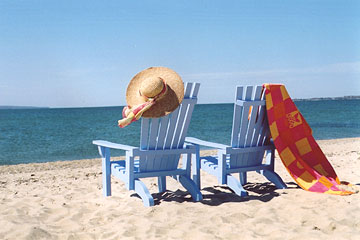Normandy summer means three-masted vessels and cows "in sunglasses"
 Rouen/Le Havre - When lovers of France think of Normandy, they picture apple orchards and meadows dotted with castles and Mont- Saint-Michel.
Rouen/Le Havre - When lovers of France think of Normandy, they picture apple orchards and meadows dotted with castles and Mont- Saint-Michel.
Mentioning the River Seine to them is more likely to conjure up images of Paris than of the region around the English Channel. But the Seine is also one of Normandy's tourist magnets, and this year in particular.
From July 5 to 14, the city of Rouen, on the Seine about 120 kilometres from the English Channel, will host Armada 2008, the world's largest windjammer parade. The some 40 tall ships and yachts that will be on display are expected to draw as many as 10 million visitors to the festivities, which are held in Rouen every four or five years.
The crowds will be able stroll along the harbour promenade and admire the three-masted vessels, which will be open to the public. Concerts and fireworks are planned in the evenings.
The new Gustave Flaubert Bridge will be inaugurated during Armada, initially for pedestrians only. A concrete-and-steel lift bridge stretching 670 metres across the Seine, it will later be opened to motor vehicles as well.
Visitors often regard Rouen's historic centre as idyllically medieval, with its rows of half-timbered houses and narrow streets ideal for sauntering.
Notre Dame Cathedral is spectacular. Rising 151 metres, it holds the tombs of Norman dukes and the English king Richard the Lion- Hearted. Every evening in the summer, a light-and-sound show turns the cathedral's facade into a mystical canvas upon which paintings and patterns by Claude Monet and other artists are projected to the accompaniment of specially composed organ music.
St Joan of Arc Church, at Place du Vieux-Marche (Old Market Square), elicits goosebumps. A large cross in front marks the spot where France's national heroine, canonized in 1920, was burned at the stake as a heretic on May 30, 1431. The church, with splendid Renaissance stained-glass windows and a wooden roof resembling flames, has dominated the square since
1979.
It would be a shame to remain at one place in Normandy, however. There are so many villages and landscapes to discover here, a region that is more than Camembert, Calvados and cows. And it does not rain as often in Normandy as people believe.
"If it always rained here, our cows wouldn't need sunglasses," as the Normans say.
Indeed, many of the cows have brown rings around their eyes that make them look as though they are wearing sunglasses.
Possible destinations include the eerie-looking abbey at Jumieges, which Vikings burned down in 841. There is also Honfleur, a coastal town that has always attracted many artists, as well as Claude Monet's former house in Giverny, whose spacious garden includes the famous pond with water lilies that he loved to paint.
Le Havre, at the mouth of the Seine, has a charm of its own. Largely destroyed during World War II, its centre was rebuilt in a uniform style under the supervision of architect Auguste Perret (1874-1954). Apartments for 60,000 people went up, as well as schools, churches and public buildings.
Due to the shortage of construction material, Perret processed the city's war rubble into unique kinds of concrete by grinding it up, separating it according to colour, and mixing it with pebbles and small shards of glass. While some visitors may cringe at the sight of the homogeneous buildings, for Perret they were "poetry" cast in concrete.
Le Havre's Saint Joseph Church is also made of concrete. Its octagonal steeple, 110 metres high, resembles a lighthouse. Light falls into the interior through 6,500 windowpanes whose colours vary depending on the points of the compass: The shades are cold in the east and north, and golden and warm in the west and south.
Considered a 20th-century architectural masterpiece, the church is dedicated to victims of the mainly British bombing raids on the German-held city.
Normandy is a a region of contrasts, comprising the old and new, big-city flair and medieval lanes, simple country inns and fashionable gourmet restaurants, concrete buildings and green meadows. All of this exists side by side.
The same applies to Armada in Rouen, where small barges will ply the Seine directly alongside large sailing ships from all over the world. (dpa)